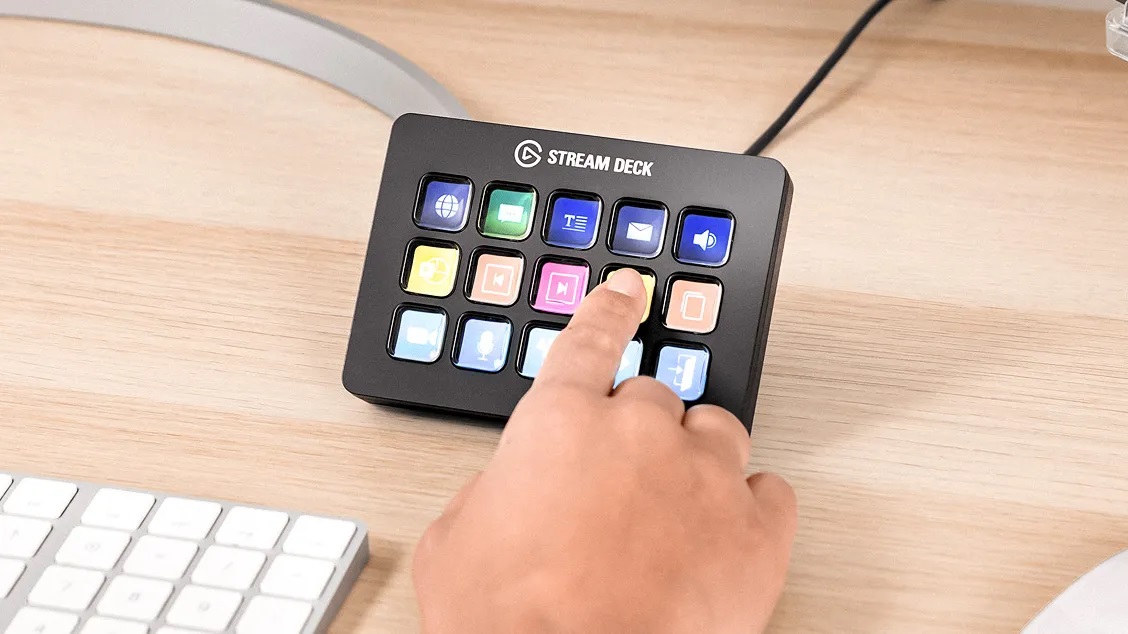Trados Studio is a powerful tool that almost everyone in the language service industry is familiar with. As a localization project coordinator, I use Trados every day to set up client orders, send packages to freelance linguists, and more. However, since I have established workflows for most of these tasks, I found myself scrolling through the same menus and clicking the same buttons over and over. Repetitive tasks like selecting a series of batch tasks to run could easily be automated, saving me a ton of clicking and maybe even an extra few seconds to have some coffee. That’s where the Stream Deck comes in.
If you’re unfamiliar, the Stream Deck is a piece of desktop hardware that is essentially a programmable keyboard. The device and accompanying software application were developed by Elgato, and were originally designed for use by streamers. The Stream Deck is able to open files, play A/V content, perform multi-step hotkey sequences, control lights, and much more. The Stream Deck I use is the standard 15-key array, though extra large and mini versions are also available.
The Stream Deck app is where the real magic comes in, with many pre-programmed options for hotkeys that just need to be drag-and-dropped into your setup. For the majority of my Trados automation keys, I used the Multi-Action function to layer hotkeys into sequences. This was surprisingly easy to set up, as Trados Studio already has alt key mapping built into the interface.
Alt Key Mapping
If you open Trados and hold down the ALT key, after a few seconds, small black boxes with letters will appear across the menus and upper ribbon. Pressing the corresponding letters will open the menu or ribbon function it is assigned to. This is important, as (to my knowledge) the Stream Deck can’t operate a mouse or click on things, but can use all keyboard functionalities.

For example, hitting ALT + H opens the home tab on the menu, B1 then opens the Batch Tasks lists and F selects Finalize. But that’s still a lot of things to be pressing. With the Multi-Action button option in the Stream Deck app, a list of hotkeys to be “pressed” in order can be created. This string of hotkeys consolidates all the actions needed to finalize a project into one button press.

Sometimes it is also necessary to add in short delays. For the sequence above, I know that there is going to be a moment of processing while Trados finalizes a project. If I hadn’t added in the delays, then the Stream Deck have continued the sequence, without actually pressing a button in the program. In this case, the final Return hotkey is to close the finalization window. Without the delays, the Stream Deck would hit return before the finalization process was finished, leaving the window open in the end.

An unlimited number of hotkeys can be layered into Multi-Action sequences, meaning that with enough refining, the Stream Deck could carry out entire project management workflows with the press of a button. This button accepts all changes in a document and runs the verify function. I have another button that combines this sequence with the finalization sequence above, resulting in an automated finalization process that saves me tens of clicks per use. With cascading hotkey sequences, one press of a button can do almost anything.
For users who are more knowledgeable about macros, the Stream Deck also has an AutoHotkey plugin. The plugin allows users to import existing macros into the Stream Deck and assign them to keys.
Profiles

A fairly obvious limitation of the Stream Deck is the number of programmable buttons available. A 15-key array’s real estate could get filled up extremely quickly, forcing the user to prioritize what to dedicate buttons to. That’s where profiles, and subsequently smart profiles, can come in. Each new profile gives the user another 15 keys to use, which is further compounded by gathering keys in folders. Switching between profiles is very quick and easy, which essentially negates the physical limitations of how many keys are actually on the array. Another major benefit of the profiles is their shareability. Once a profile is created, it can be exported. Downloading the profile to any other Stream Deck gives the new Stream Deck full access to the programmed buttons.
In this case, where I work with many other project coordinators and project managers using very similar Trados workflows, this shareability has been extremely handy. By hosting the profiles on a SharePoint site, the entire project management team has the same access to these hotkeys.
Smart Profiles
Profiles can also be turned into smart profiles by assigning them to specific programs. When the program is opened, the Stream Deck will automatically switch the UI to display the relevant profile’s keys. Programs can also be open in the background, and the Stream Deck will switch the display once the assigned program is active again. This means that the buttons on my Trados profile are immediately usable when I’m using Trados, but also that I don’t have to bother switching profiles when I want to return to my default profile to use buttons for Teams, Outlook, etc.

Productivity
Of course, the Stream Deck’s automation capabilities are limited to just Trados. We have found the Stream Deck to be massively useful for billing, managing Teams calendars and calls, creating email templates in Outlook, processing documents in Microsoft Office, and pricing calculations. What I have worked to personally create for my organization also doesn’t even begin to tap into the incredible resources available via plugins. The plugin store has categories for business tools, developer tools, productivity, and finance, in addition to all the streaming and gaming resources. It is a tool that has been massively beneficial to the project management team at my organization, as well as my personal use.
In A Nutshell


